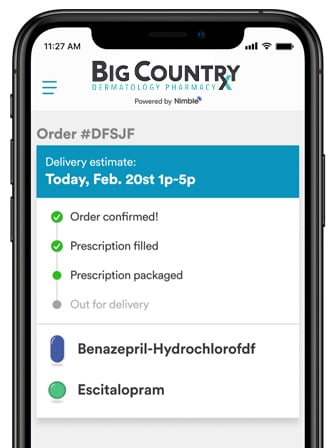Triple rosacea cream contains 3 active pharmaceutical ingredients: azelaic acid, which has antioxidant and anti-microbial properties, ivermectin, a topical anti-parasitic that decreases inflammation, and metronidazole, a topical antibiotic, with anti-inflammatory properties. Providers often prescribe these three medications together to reduce the inflammatory lesions and redness associated with rosacea.
Topics: dermatology, prescription, medication, compounds, Counseling Corner, cream, triple, rosacea
Compound Medication and The claRx Guarantee
Compounding medications is an encompassing process, allowing pharmacists to combine, or mix various ingredients to create medications not available by manufacturers. Similar to baking a cake, many pharmacies may use the same ingredients to create a compound with the same intended end result, and yet you will find vastly different qualities of cake from different bakers. The same holds true for compounds from different pharmacies.
Topics: medication, compounding, guarantee
Providers, pharmacies, and patients all have a part to play in the iPledge program if the patient is going to take Accutane. We break this down into 3 parts and how we improve outcomes in each one.
Topics: dermatology, medication, guarantee, patient care, iPledge
The Ideal Pharmacy for Patients and Dermatologists
Every patient should have the opportunity to use a pharmacy that is an expert in their field of medicine. At claRx Big Country Dermatology Pharmacy, we are experts in dermatology pharmacy and focus on providing the best experience possible for patients and providers. This results in saving patients money and saving providers time.
Topics: dermatology, medication, patient care, pricing, explained, dermatologist, pharmacy
Medication Pricing Explained (Behind the Curtains)
Paying for medication at a pharmacy is a more complicated process than what meets the eye. The cost varies due to the medication and whether the patient is insured or not along with how the insurance company covers the specific medication. To help simplify it, we have broken down what an insured patient may pay for medication into a few categories, and also establish how an insurance company typically determines the price for the medication in the first place.
Topics: dermatology, prescription, medication, pricing, insured, deductible, explained
Utilizing Manufacturer Rebates to Save Patients Money
Here at claRx Big Country Dermatology pharmacy, we work in a symbiotic relationship with the manufacturers that make many of the medications we dispense. We do this by participating in their rebate programs, which are designed to reduce the out of pocket cost to patients on specific medications. Manufacturer rebates are not available for all medications, and they do not help every patient. We believe it is our duty in the dermatology industry to do the most good for most people, which means, when these programs are available for a specific patient, we utilize them.
Topics: dermatology, prescription, medication, compounds, Counseling Corner, manufacturer, rebate, save
Self-pay pricing varies a great deal from pharmacy to pharmacy. It can be based on a huge number of different factors, from cost, to likeliness of driving future business, to expiration dating, to normally reimbursement rates of insurance companies.
It is important to know that, in many cases, a patient can even be better off not using their insurance and instead use a self-pay program at a pharmacy. This is especially true in dermatology, where many medications are categorized as a cosmetic need and not an actual medical need.
This is why a patient needs to better understand the options that are available to them so that they know what pharmacy to go to for their medication.
Topics: dermatology, prescription, medication, compounds, Counseling Corner, self-pay, pricing
Dermatologists often prescribe the active ingredients that you find in our Triple Lightening cream to treat uneven skin tone and pigmentation caused by sun exposure or hormonal changes, or possibly to improve the appearance of acne scars. Our triple lightening cream consists of a steroid, which is either triamcinolone or hydrocortisone, hydroquinone, a bleaching agent, and tretinoin, which is a retinoid that helps bring skin cells to the surface.
Topics: dermatology, prescription, medication, compounds, Counseling Corner, cream, triple, lightening
Why Compounded Medications Instead of Commercially Available Ones?
In today’s pharmaceutical world, there are many commercial drugs available to treat all kinds of conditions. This leads to many patients wondering why they need a compounded medication if there are so many other commercially available and mass manufactured medications that could treat their condition?
The short answer to this question is, if the more commercially available medication is able to better treat their condition, then they should definitely use that medication. Most providers prescribe ten or 20 times more commercially made medications than compounded ones for this same reason. But what happens when there is no commercially available medication to treat their condition? This is when a patient should use a compounded medication.
Topics: dermatology, prescription, medication, compounds, Counseling Corner
Here at claRx Big Country Dermatology Pharmacy, we offer a variety of wart peel products. Our wart peels come in cream, ointment, and liquid formulations. Most wart peel products contain salicylic acid, which softens the skin cells and leads to peeling. They usually contain fluorouracil, which works by interfering with cell DNA, which leads to cellular death in the targeted area. Some of the wart peel ointments contain podophyllin, which interferes with cell division and the formation of new wart skin cells.
Topics: dermatology, prescription, medication, compounds, Counseling Corner, wart, peel



